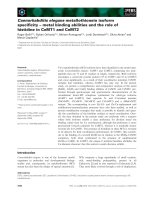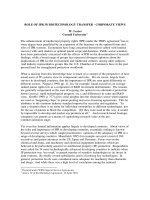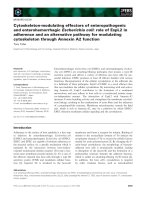Role of h2s in acute and chronic inflammation
Bạn đang xem bản rút gọn của tài liệu. Xem và tải ngay bản đầy đủ của tài liệu tại đây (2.73 MB, 76 trang )
ROLE OF HYDROGEN SULFIDE IN ACUTE AND CHRONIC
INFLAMMATION
DAVID NG SHEN WEN
(B.Sc. (Hons.), NATIONAL UNIVERSITY OF SINGAPORE)
A THESIS SUBMITTED
FOR THE DEGREE OF MASTER OF SCIENCE
DEPARTMENT OF PHARMACOLOGY
YONG LOO LIN SCHOOL OF MEDICINE
NATIONAL UNIVERSITY OF SINGAPORE
2014
DECLARATION
I hereby declare that this thesis is my original work and it has been written by me in its
entirety. I have duly acknowledged all the sources of information which have been used in
the thesis.
This thesis has also not been submitted for any degree in any university previously.
______________________
David Ng Shen Wen
20 August 2014
I
ACKNOWLEDGEMENTS
I would like to express my heartfelt gratitude to my supervisor, Prof. Philip Keith Moore
for giving me the opportunity to work on this research project and his guidance. I would also like
to thank my co-supervisor, A/Prof. Low Chian Ming for his advice.
I would like to thank Dr. Mohamed Shirhan Bin Mohamed Atan, Dr. Li Ling, Dr. Tsai
Chin-Yi, Ms. Peh Meng Teng, Mr. Huang Weihao Caleb and Ms. Ng Li Theng, for their help
over the course of the project.
Finally, I would also like to thank my family for their support throughout my studies.
II
TABLE OF CONTENTS
DECLARATION…………………………………………………………………………………I
ACKNOWLEDGEMENTS…………………………………………………………………….II
TABLE OF CONTENTS………………………………………………………………………III
SUMMARY……………………………………………………………………………………VII
LIST OF FIGURES………………………………………………………………………….VIII
ABBREVIATIONS…………………………………………………………………………….IX
CHAPTER 1: Introduction and Overview……………………………………………………..1
1
Introduction……………………………………………………………………………….2
1.1
Hydrogen Sulfide – overview and historical perspective…………………………2
1.2
Physical and chemical properties of H2S………………………………………….2
1.3
Biosynthesis of H2S……………………………………………………………….3
1.4
Biological effects and physiological functions of H2S……………………………4
1.5
Research Objectives……………………………………………………………….8
CHAPTER 2: Effects of administration of a high fat diet on H2S metabolism in mice……..9
2
Introduction………………………………………………………………………………10
2.1
Materials and methods…………………………………………………………...13
2.1.1
Animals and diet…………………………………………………………13
III
2.2
2.1.2
Measurement of tissue H2S synthesizing enzyme activity………………13
2.1.3
Measurement of plasma H2S concentration……………………………...14
2.1.4
Western blotting for H2S synthesizing enzymes…………………………15
2.1.5
Measurement of plasma cytokine and chemokine levels………………...16
2.1.6
Measurement of plasma SAA and CRP levels…………………………..16
2.1.7
Immunohistochemistry staining for CSE, CBS and 3-MST……………..16
2.1.8
Oil red O staining………………………………………………………...17
2.1.9
Statistics………………………………………………………………….17
Results……………………………………………………………………………18
2.2.1
Effect of a high fat diet on plasma H2S concentration…………………...18
2.2.2
Effect of a high fat diet on CSE, CBS and 3-MST expression…………..19
2.2.3
Effect of a high fat diet on tissue H2S synthesising activity……………..21
2.2.4
Effect of a high fat diet on vascular H2S synthesizing enzyme
localisation……………………………………………………………….23
2.3
2.2.5
Effect of a high fat diet on plasma cytokines and chemokines…………..25
2.2.6
Effect of a high fat diet on plasma SAA and CRP levels………………..28
2.2.7
Effect of a high fat diet on lipid deposition in aorta……………………..29
Discussion………………………………………………………………………..31
IV
CHAPTER 3: Effects of endotoxin tolerance on H2S metabolism in mice………………….35
3
Introduction………………………………………………………………………………36
3.1
3.2
Materials and methods…………………………………………………………...39
3.1.1
Animals and treatment groups…………………………………………...39
3.1.2
Measurement of plasma IL-1β, IL-6 and TNF-α levels………………….40
3.1.3
Measurement of myeloperoxidase activity in tissues……………………40
3.1.4
Haematoxylin and eosin staining………………………………………...41
3.1.5
Measurement of plasma H2S concentration……………………………...41
3.1.6
Western blotting for H2S synthesizing enzymes…………………………41
3.1.7
Measurement of tissue H2S synthesizing enzyme activity………………41
3.1.8
Statistics………………………………………………………………….42
Results……………………………………………………………………………43
3.2.1
Effect of endotoxin tolerance on inflammatory cytokines in plasma……43
3.2.2
Effect of endotoxin tolerance on myeloperoxidase activity in tissues…...45
3.2.3
Effect of endotoxin tolerance on cell infiltration and tissue remodelling..46
3.2.4
Effect of endotoxin tolerance on plasma H2S concentration…………….48
3.2.5
Effect of endotoxin tolerance on CBS, CSE and 3-MST expression……48
3.2.6
Effect of endotoxin tolerance on tissue H2S synthesising activity………51
V
3.3
Discussion………………………………………………………………………..53
CHAPTER 4: Conclusion……………………………………………………………………...55
4
Conclusion……………………………………………………………………………….56
BIBLIOGRAPHY………………………………………………………………………………58
VI
SUMMARY
H2S been reported to exhibit both pro-inflammatory and anti-inflammatory properties. In this
study, we evaluated the contribution of the H2S system in two different models of inflammation.
In the first model, we fed mice a high fat diet over a period of 16 weeks to induce a chronic low
grade inflammatory model. We observed that the CSE expression and H2S biosynthesis in high
fat fed mice was reduced by approximately 50% compared to normal diet mice. As these changes
occurred prior to the development of atherosclerosis, these results suggest that H2S deficiency
may predispose mice to atherosclerosis. In the second model, we injected mice with LPS to
induce an acute inflammatory state. Mice re-exposed to LPS developed a state of endotoxin
tolerance. CSE expression and H2S biosynthesis in endotoxin tolerant mice was observed to be
reduced by approximately 25% compared to endotoxic shock mice. We observed down-regulated
CSE expression and reduced H2S biosynthesis in the models of high fat fed and endotoxin
tolerant mice. These results give us an insight into the roles of H2S during the early stages of
atherosclerosis and endotoxin tolerance. The results also opens up the possibility of using the
H2S system as a therapeutic target in early atherosclerosis and endotoxin tolerance.
VII
LIST OF FIGURES
Figure 1. The biosynthesis of H2S within mammalian tissues…………………………………….4
Figure 2. Therapeutic targets for H2S……………………………………………………………..8
Figure 3. Plasma H2S concentration……………………………………………………………..18
Figure 4. Expression of CBS, CSE and 3-MST………………………………………………….20
Figure 5. Biosynthesis of H2S……………………………………………………………………22
Figure 6. Representative photographs of IHC staining in aorta………………………………….24
Figure 7. Plasma concentration of cytokines and chemokines…………………………………..26
Figure 8. Plasma concentrations of biochemical markers of atherosclerosis……………………28
Figure 9. Representative photographs showing Oil red O staining for lipid in aorta……………30
Figure 10. Plasma concentration of inflammatory cytokines……………………………………44
Figure 11. Myeloperoxidase activity…………………………………………………………….46
Figure 12. Representative photographs of histological changes within liver and lung………….47
Figure 13. Plasma H2S concentration……………………………………………………………48
Figure 14. Expression of CBS, CSE and 3-MST………………………………………………...50
Figure 15. Biosynthesis of H2S…………………………………………………………………..52
Figure 16. Experimental flowchart……..………………………………………………………..57
VIII
ABBREVIATIONS
Symbols
Full name
3MP
3-mercaptopyruvate
3-MST
3-mercaptopyruvate sulfurtransferase
AP-1
Activator protein 1
ApoE-/-
Apolipoprotein E-deficient
ATB-346
2-(6-methoxy-napthalen-2-yl)-propionic acid 4-thiocarbamoylphenyl ester
BSA
Bovine serum albumin
C19H42BrN
Hexadecyltrimethylammonium bromide
cAMP
Cyclic adenosine monophosphate
CARS
Compensatory anti-inflammatory response syndrome
CAT
Cysteine aminotransferase
CBS
Cystathionine β synthase
CD11b/CD18
β2 integrin Mac-1
CD36
Cluster of differentiation 36
CL
Cysteine lyase
CO
Carbon monoxide
COPD
Chronic obstructive pulmonary disease
IX
CRP
C-reactive protein
CSE
Cystathionine γ lyase
DTT
Dithiothreitol
ERK
Extracellular signal-regulated kinases
FeCl3
Iron (III) chloride
G-CSF
Granulocyte-colony stimulating factor
GMP
Guanosine monophosphate
GYY4137
Morpholin-4-ium 4 methoxyphenyl (morpholino)
phosphinodithioate
H2S
Hydrogen sulfide
HCl
Hydrochloric acid
HMG-CoA
3-hydroxy-3-methylglutaryl-coenzyme A
HPLC
High-performance liquid chromatography
IACUC
Institutional Advisory Care and Use Committee
ICAM-1
Intracellular adhesion molecule 1
IFN-γ
Interferon gamma
IHC
Immunohistochemistry
IKK
IκB kinase
IL
Interleukin
X
KATP
ATP-sensitive potassium
KC
Keratinocyte chemoattractant
LL
LPS+LPS
LPS
Lipopolysaccharide
MAPK
Mitogen-activated protein kinase
MBB
Monobromobimane
MCP-1
Monocyte chemotactic protein 1
MIP
Macrophage inflammatory protein
MPO
Myeloperoxidase
MyD88
Myeloid differentiation primary response gene 88
NaHS
Sodium hydrosulfide
NF-κB
Nuclear factor kappa-light-chain-enhancer of activated B cells
NMDA
N-methyl-D-aspartic acid
NO
Nitric oxide
NUS
National University of Singapore
OxLDL
Oxidised low density lipoprotein
P5P
Pyridoxal 5’-phosphate
PAMPs
Pathogen-associated molecular patterns
XI
PBS
Phosphate buffered saline
PRR
Pattern recognition receptors
RANTES
Regulated on activation, normal T expressed and secreted
ROS
Reactive oxygen species
SAA
Plasma serum amyloid A
SDS–PAGE
Sodium dodecyl sulfate polyacrylamide gel electrophoresis
SEM
Standard error of mean
SL
Saline+LPS
SRA
Scavenger receptor class A
SS
Saline+saline
TBS
Tris-buffered saline
Th1
T helper 1
Th17
T helper type 17
TIR
Toll-interleukin-1 receptor
TLR4
Toll-like receptor 4
TNF-α
Tumor necrosis factor alpha
VCAM-1
Vascular cell adhesion molecule 1
XII
Chapter 1
Introduction and Overview
1
1
Introduction
1.1
Hydrogen Sulfide – overview and historical perspective
Hydrogen sulfide (H2S) is a colourless gas with the distinctive odor of rotten eggs [1]. Until
recently, H2S was widely regarded as a noxious gas. H2S is naturally occurring within volcanoes,
sulfur springs and swamps. H2S is also produced by the petrochemical industrial activities and by
tanneries. H2S has been known for many years to inhibit cytochrome c oxidase, an essential
enzyme for mitochondrial respiration [2]. Even with the characteristic odour of H2S, individuals
may be unaware of its presence in the air as the sense of smell is severely compromised by H2S
concentrations above 150 ppm [3]. Exposure to H2S concentrations of above 500 ppm leads to
respiratory paralysis, unconsciousness and may consequently result in death [4].
In the past two decades, the view that H2S is purely an environmental pollutant has been
increasingly challenged and is no longer tenable. Indeed, H2S is now seen as an endogenous
biologically active molecule with a range of significant functions inside the body. In this regard,
H2S influences numerous signaling processes within cells. H2S is now classified alongside nitric
oxide (NO) and carbon monoxide (CO) as gasotransmitters. As the newest member of the
gasotransmitter family there has been considerable interest in the biology of H2S
1.2
Physical and chemical properties of H2S
H2S is able to diffuse readily through plasma membranes without the help of membrane
transporters. H2S dissolves freely in water to form a weak acid which dissociates as follows: H2S
2
↔ HS- + H+. Dissolved H2S under physiological conditions of pH 7.4 at 37oC, will exist
predominantly as the hydrosulfide anion (HS-, 81.5%) compared to 18.5% as H2S [5]. H2S is a
powerful reducing agent as it is easily oxidized.
1.3
Biosynthesis of H2S
H2S production within mammalian tissues occurs via both enzymatic and non-enzymatic means
[6; 7; 8; 9]. Generation of H2S via non-enzymatic means occurs through the reduction of thiols.
Using L-cysteine as a starting material, H2S can be synthesized by at least four distinct routes
enzymatically [6]. These four routes are: (i) cystathionine γ lyase (CSE) produces thiocysteine
from cystine, which then reorganizes to produce H2S; (ii) cystathionine β synthase (CBS) works
on L-cysteine to create H2S and L-serine; (iii) cysteine aminotransferase (CAT) working in
concert with 3-mercaptopyruvate sulfurtransferase (3-MST) to produce H2S with 3mercaptopyruvate as the intermediary product; (iv) cysteine lyase (CL) catalyzes L-cysteine and
sulfite to H2S and L-cysteate. These enzymes occur in mammalian tissues and are differentially
expressed. CBS is abundantly expressed in brain whereas CSE is the predominant enzyme in
liver, kidney and smooth muscle cells. CAT and 3-MST are primarily localized within
mitochondria [10]. CSE, CBS, CAT and CL need pyridoxal 5’-phosphate (P5P) as a cofactor. 3MST requires zinc as cofactor. H2S can also be synthesized from homocysteine in a reaction
catalyzed by CBS. The four enzymatic pathways that catalyze H2S production are shown in
Figure 1.
3
Figure 1. The biosynthesis of H2S within mammalian tissues.
Figure taken from Li et al., (2011) [6].
1.4
Biological effects and physiological functions of H2S
H2S, which has been long viewed purely as an environmental pollutant, has in recent years
increasingly come to be recognized as an influential biological molecule with important
physiological roles. Recently, there has been an abundance of reports illustrating the role of H2S
in diverse fields such as cardiovascular, reproductive, neurobiology and inflammation [5; 6; 11;
12; 13; 14]. These studies have not only considerably increased our understanding of H2S but
have additionally illuminated the complexity of this seemingly chemically simple gas.
4
Within the cardiovascular system, H2S acts as a physiological vasodilator, modulator of blood
flow within the microcirculation and regulator of blood pressure through the opening of ATPsensitive potassium (KATP) channels within vascular smooth muscle cells [15; 16; 17]. In
contrast, lack of endogenous H2S may contribute to the development of hypertension [18]. H2S
promotes angiogenesis and is anti-atherosclerotic in nature [19; 20]. During atherosclerosis, there
is oxidative stress due to increased formation of reactive oxygen species (ROS). Oxidative stress
promotes proliferation of vascular smooth muscle cells and increased foam cell formation which
are key steps in atherosclerosis. H2S can directly quench ROS with its strong reducing properties
and inhibit ROS production [21; 22]. Within atherosclerotic lesions, there is massive
proliferation of vascular smooth muscle cells. H2S inhibits vascular smooth muscle cells
proliferation and also induces apoptosis of vascular smooth muscle cells [23]. Foam cells
formation from macrophages by OxLDL is critical for the initiation and progression of
atherosclerotic lesions. H2S was shown to inhibit formation of foam cells [24]. In CSE knockout
mice, a deficiency of endogenous H2S has been associated with accelerated atherosclerosis [25].
In reproductive biology, H2S relaxes both the corpus cavernosum and vaginal smooth muscles
again through the modulation of KATP channels. These data suggest that sexual function may, at
least partly, be controlled by H2S [11; 12].
In neurobiology, H2S has been reported to alter activity of potassium channels and curb synaptic
potentials in dorsal raphe serotonergic neurons [26]. In neurons, H2S enhances N-methyl-Daspartic acid (NMDA) receptor-mediated responses and modifies the induction of hippocampal
long-term potentiation [27]. Additionally, sensitizing of NMDA receptor by H2S been reported to
5
have a role in pain sensation [28]. H2S also been shown to confer protection on neurons from
oxidative stress and prevent neurodegeneration [29; 30].
In inflammation research, H2S exhibits both pro-inflammatory and anti-inflammatory properties.
H2S been reported to be an endogenous potentiator of T cell activation [14]. T cells interact with
many cell types and recognize a large number of pathogens. T cell activation leads to either
production of antibodies, activation of phagocytic cells or direct cell killing which are essential
components of host defense. However, uncontrolled T cell activation might result in autoimmune
destruction of cells and tissue [14]. During inflammation, H2S increases leukocyte adhesion via
activation of the β2 integrin Mac-1 (CD11b/CD18) [31].
Remarkably, this gas also has opposing roles on the effect of administration of
lipopolysaccharide (LPS). In a pro-inflammatory role, elevated H2S level and myeloperoxidase
(MPO) activity, which serves as a marker for neutrophil infiltration, were observed after either
administration of LPS or treatment with the H2S donor sodium hydrosulfide (NaHS) [32]. On the
other hand, H2S donors (NaHS and S-diclofenac) demonstrated anti-inflammatory effects
through decreased activation of nuclear factor kappa-light-chain-enhancer of activated B cells
(NF-κB) and reduced production of inflammatory cytokines [33; 34]. In a burn injury model,
H2S caused markedly increased inflammatory damage [35]. Another study reported a negative
association between endogenous H2S levels and the severity of chronic obstructive pulmonary
disease (COPD) [36]. It has been proposed that the pro-inflammatory properties of H2S might be
mediated through increased release of the neuropeptide, substance P, leading to the resultant
activation of extracellular signal-regulated kinases (ERK) and NF-κB to generate inflammatory
6
mediators such as interleukin (IL)-1β, tumor necrosis factor α (TNF-α) [37]. H2S has been
shown to ameliorate emphysema in a murine smoke exposure model [38]. H2S donors have also
been reported to possess anti-inflammatory properties in murine models of ischemia-reperfusion
injury of small intestine and colitis [39; 40]. The anti-inflammatory properties of H2S may be
partly due to inhibition of phosphodiesterase activity resulting in an increased cyclic adenosine
monophosphate (cAMP) and guanosine monophosphate (GMP) levels within aortic cells [41].
Recently, H2S was reported to function as an endogenous mediator of the resolution phase of
inflammation [42]. H2S donors that release H2S rapidly over a short period (e.g. NaHS) are
typically pro-inflammatory [32; 43]. On the other hand, H2S donors releasing H2S slowly over a
long period (e.g. morpholin-4-ium 4 methoxyphenyl (morpholino) phosphinodithioate
(GYY4137) and 2-(6-methoxy-napthalen-2-yl)-propionic acid 4-thiocarbamoyl-phenyl ester
(ATB-346)) are usually anti-inflammatory [44; 45]. As such, the overall effect of H2S in
inflammation most likely depends on the actual experimental conditions and the concentration of
H2S at the site of inflammation [6]. Apart from the H2S concentration at the site of inflammation,
another factor which may play a part in determining the involvement of this gas in inflammation,
is the duration and perhaps also the intensity of the inflammatory insult [6]. In addition to the
topics discussed above, H2S been additionally implicated in other disease states including cancer,
organ transplant and metabolic syndromes [46; 47; 48]. The above-mentioned examples serve to
illustrate the complexity and wide ranging roles of H2S across different physiological and
pathophysiological states. Consequently, H2S, and its donor drugs, are increasingly being
considered as potential therapeutic agents for a number of diseases [49; 50; 51]. An illustration
of the various potential therapeutic targets for H2S is provided in Figure 2.
7
Figure 2. Therapeutic targets for H2S.
Figure taken from Predmore et al., (2012) [51].
1.5
Research Objectives
H2S performs multiple roles in inflammation. Therefore, understanding the factors which govern
the overall effects of this gas during inflammation is essential. The present study aims therefore
to evaluate the contribution of the H2S system in two different models of inflammation. The first
such model is a chronic low grade inflammatory model produced by feeding mice a high fat diet
over an interval of up to 16 weeks whilst the second is an acute inflammatory state of endotoxic
shock following injection of mice with E. coli LPS.
8
Chapter 2
Effects of administration of a high fat
diet on H2S metabolism in mice
9
2
Introduction
Cardiovascular disease is currently one of the chief causes of mortality within developed
countries and is a leading health concern worldwide [52]. High cholesterol levels increases the
risk of cardiovascular diseases [53]. One third of heart disease cases worldwide can be attributed
to high blood cholesterol levels which is especially obvious within the developed world [52].
One of the biggest influences on high blood cholesterol levels is diet high in saturated fats [54].
Atherosclerosis is the principal cause of cardiovascular disease. Atherosclerosis is characterized
by accumulation of lipids, fibrous elements, smooth muscle cells, endothelial cells, leukocytes
and foam cells in large arteries [55]. Atherosclerosis is increasingly being recognized as an
inflammatory disease. Over the past decades, the involvement of immune cells and inflammatory
mechanisms in the development of atherosclerosis has become clear [56; 57]. During
atherogenesis, a process in which atherosclerotic plaques are formed, monocyte recruitment to
sites of lesion in large arteries occurs as an early event [56]. Circulating oxidised low density
lipoprotein (OxLDL) leads to activation of endothelial cells. The attachment of monocytes to the
activated endothelial cells is facilitated by various adhesion molecules. The two main molecules
are vascular cell adhesion molecule 1 (VCAM-1) and intracellular adhesion molecule 1 (ICAM1). The recruited monocytes undergo maturation into macrophages and releases several
mediators to further drive atherogenesis [57]. The macrophages migrate into the intima of
vasculature and increase expression of surface scavenger receptors such as scavenger receptor
class A (SRA) and cluster of differentiation 36 (CD36). These receptors bind and internalize
lipoprotein with the cells. The lipids accumulate in the macrophages to form foam cells. Foam
cells release pro-inflammatory cytokines and ROS which augments the inflammation within the
lesion. Foam cells also augment smooth muscle cell migration into the intima which drives the
10
progression of the atherosclerosis [58]. These processes result in the formation of fatty steaks.
Over time, these fatty streaks evolve into atherosclerotic plaques. The initiation and progression
of atherosclerotic plaques generally take place over many years without any symptoms. In the
event of a plaque rupture, acute thrombosis occurs by activation of platelets and triggering of the
clotting cascade. Depending on the location of the clot, the thrombotic event may be serious or
life-threatening.
H2S performs several roles during inflammation. These include dilation of blood vessels and
regulation of leukocyte adhesion [15; 31]. The role of H2S in atherosclerosis has been well
documented [59]. It has been reported that apolipoprotein E-deficient (ApoE-/-) mice have
lowered plasma H2S levels with increased plasma ICAM-1 concentrations [20]. This is
interesting since ApoE-/- mice are known to develop atherosclerosis spontaneously even when
fed a normal diet. Proliferation of vascular smooth muscle cells is one of the key features of
atherosclerosis. H2S been described to induce apoptosis and suppress the proliferation of
vascular smooth muscle cells [23]. These suggest that H2S may be protective against
atherosclerosis [60]. During the progression of atherosclerosis, the increased ROS formation
within the lesion results in oxidative stress which plays an important function in driving the
atherosclerotic process. H2S can directly quench ROS with its strong reducing properties [21].
Additionally, H2S also been shown to inhibit ROS production [22]. The H2S donor, NaHS
inhibited the formation of foam cells from macrophages by OxLDL [24]. H2S also reduced the
extent of aortic lesions in ApoE-/- mice [20; 61]. CSE knockout mice, which suffer from
deficiency of endogenous H2S have accelerated development of atherosclerosis [25]. Taken
together, a strong case can be made that deficiency of H2S is linked with the development of
11
atherosclerosis. Whether there are any changes to the metabolism of H2S in mice before the
development of atherosclerotic lesions in animals or in man is not clear. Moreover, whether such
changes, if they occur, would be good predictors of future development of atherosclerosis is also
unclear. In this work, I examine whether administration of a high fat diet to mice affects tissue
H2S biosynthesis and synthesising enzymes as well as plasma markers of both inflammation and
atherosclerosis.
12









